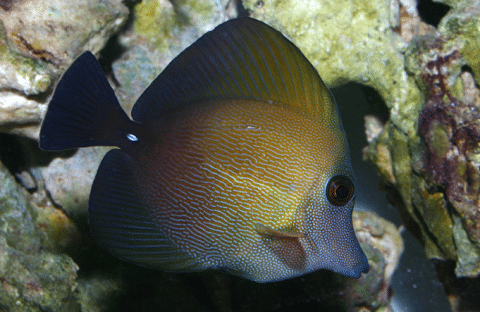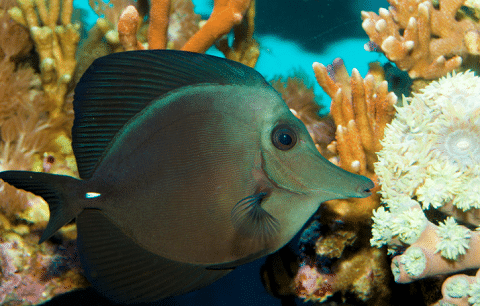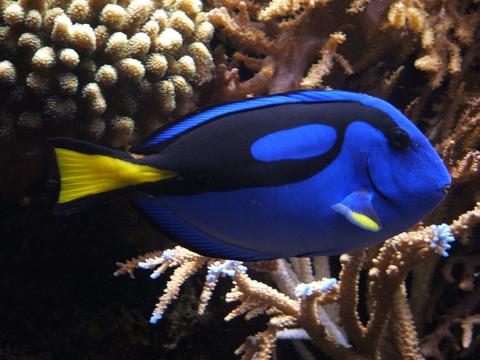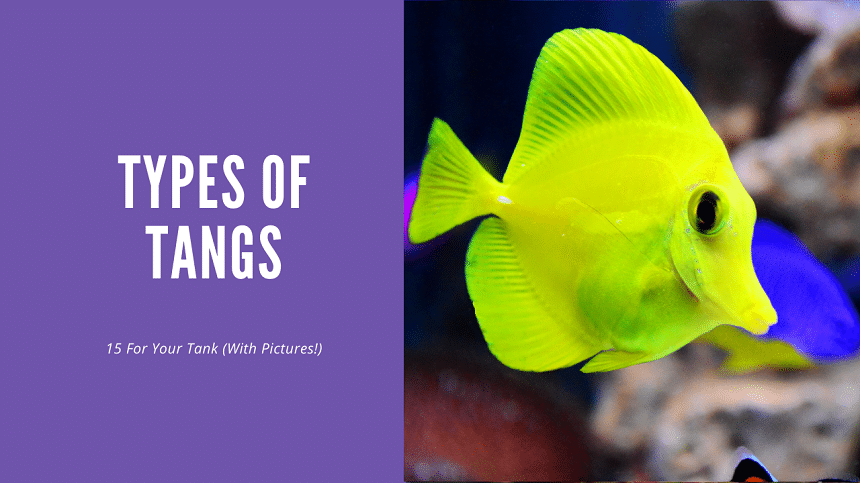Thank you for visiting! By the way… any links on this page that lead to products on Amazon and other stores/partners are affiliate links Aquarium Store Depot earns a commission if you make a purchase.
Tangs are one of the most recognizable species of marine fish, perhaps second only to the clownfish. One of the most notable members of this group is a hippo tang (Paracanthurus hepatus) named Dory from Pixar’s popular fish movie.
In the aquarium, these fish are known for their bright colors and high activity levels.
How Many Species Of Tangs Are There?
There are many species of tang available in the aquarium hobby but even more exist in the wild, amounting to almost 90 known species. Most of these species originate from the warm waters of the Indo-Pacific, where they travel from reef to reef searching for algae to graze on.
These fish may also be known as surgeonfish due to the scalpel-like spine located at the base of their tails which is capable of inflicting some serious injury to predators. Some tangs are able to excrete venom from this scalpel while others are poisonous to ingest.
What Is The Rarest Tang?
As of 2020, one of the rarest tangs available in the aquarium hobby was an Anubis hybrid. This fish is a mixture of purple tang and scopas tang to create a bright yellow-bodied fish with a spectacularly dark overlay of intricate patterning.
Aside from morphs, some of the most desired species are gem tangs and black tangs.
Requirements And Temperament
Tangs aren’t the hardiest of fish, but luckily, they’re not the most delicate either. With so many types of tangs to choose from, each list of requirements will be unique to the species.
In general, most tang species are more susceptible to disease than other standard aquarium fish. That being said, they can quickly bounce back to full health given the right attention and care. To keep your tang from getting sick, always allow at least a two-week quarantine period (I recommend longer) before adding it to your main display.
This display should be at least 70 gallons for smaller, less active types of tangs. Otherwise, these are very active fish that need both open swimming space and rockwork to graze on algae. They can be kept at standard saltwater aquarium parameters:
- pH: 8.0-8.4
- Alkalinity: 8.0-12.0
- Salinity: 1.020-1.025
- Temperature: 72-82° F
Are They Aggressive?
More than likely, your tang will be aggressive. They are generally labeled as semi-aggressive saltwater fish, though they definitely have the ability to injure and kill other fish especially those that might be similar in appearance.
Some types of tangs, like yellow tangs, are particularly known for beating up other fish for no reason at all. To help prevent this from happening in your own aquarium, it’s best to introduce a school of tangs together at once; it should be noted that aggression can and probably will happen in these social groups as the bigger and stronger fish weed out the weakest ones.
It is also recommended to add tangs as the last addition to the overall stocking list. This will allow other fish to establish a territory that they feel comfortable defending until your tang comes and tries to claim it as its own.
Though most aggressive tangs can be dealt with, some hobbyists have had to rehome their pet fish because nothing was working to diffuse the behavior. Check out the video above from Reef Nerd for a good overview on dealing with aggression.
One of the best rules of thumb is to mix different sub-species of Tangs. Because they look different, they tend to not display as much aggression to tangs of the same species. I’ll explain the main species a bit later in the post.
Are They Easy To Keep?
In general, yes tangs are easy saltwater fish. As mentioned before, they can be a little difficult to acclimate to the tank but will thrive if conditions are met.
Apart from possible aggression, one of the challenges to keeping tangs is keeping them fed. In established coral reefs, they will get most of their herbivorous needs from the rockwork. However, this will need to be supplemented with pieces of dried algae, algae flakes, algae wafers, and a high-quality marine flake or pellet.
This specialized diet can be an additional cost but is necessary for the long-term success of the fish.
Types – The 4 Different Species
Tangs are broken down into 4 main species in our hobby. Each has different characteristics. They are:
- Zebrasoma
- Ctenchaetus
- Acanthurus
- Naso
Zebrasoma spp.
The Zebrasoma genus contains one of the most popular species of tang, the yellow tang.
These fish are categorized by their compact, flattened bodies and sail-like fins. They are some of the most desirable for the home reef system.
Ctenochaetus spp.
Ctenochaetus tangs are pretty easy to recognize from Zebrasoma species. These tangs have a more elongated body, with a curved dorsal fin and truncated tail.
Fish from this genus don’t tend to be as popular as those in Zebrasoma, but this group contains some recognizable faces like kole tangs. Some fish in this genus are also known as bristletooth tangs due to the teeth they use to scrape away algae from rocks.
Acanthurus spp. & Paracanthurus spp.
The Acanthurus genus has some of the less popular species while Paracanthurus has only one very popular species, the Dory fish.
These fish have wide, streamlined bodies for traveling long distances. In general, members of these genera grow to be considerably larger than Zebrasoma and Ctenochaetus.
Naso spp.
The Naso genus has some interesting fish in terms of color, shape, and body ornaments. These fish also have a very streamlined, yet squashed appearance to them. They can grow to considerable sizes, making most species in this genus unattainable for the average hobbyist.
15 Different Species (With Pictures)
In order to understand the many different kinds of tang available in the aquarium hobby, we’ve compiled a list of the most popular species by genus. Check out the video below from our YouTube Channel. We go over in more detail in the blog post below:
1. Yellow (Zebrasoma flavescens)

- Species Type – Zebrasoma
- Scientific Name: Zebrasoma flavescens
- Size: 8″
- Origin: Pacific Ocean
- Tank Size: 125 gallons
- Available As Tank Bred: Yes
The yellow tang is an unmistakenly vibrant yellow. These fish grow to be about 8 inches and need a minimum tank size of 125 gallons with intricate rockwork for grazing on algae and for free swimming room.
Yellow tangs can be kept in schools in large systems, but they have also been known to be aggressive to their own species as well as to similar-looking species.
Yellow tangs have a very large native range, primarily throughout the Pacific Ocean though they have been documented off the coast of Florida as well.
2. Purple (Zebrasoma xanthurum)

- Species Type – Zebrasoma
- Scientific Name: Zebrasoma xanthurum
- Size: 10″
- Origin: Red Sea
- Tank Size: 125 gallons
- Available As Tank Bred: Yes
The purple tang has become a very desirable species over the past few years, reflecting on its market price. These western Indian Ocean fish are a beautiful velvety purple-blue with accented yellow tail fin; upon closer observation, some darker horizontal lineations are also apparent across the body.
Purple tangs can grow to be slightly larger than yellow tangs, reaching a maximum size of about 10 inches. They can usually be safely kept with yellow tangs in a 125 gallon aquarium, though there may be some aggression from time to time.
3. Gem (Zebrasoma gemmatum)

- Species Type – Zebrasoma
- Scientific Name: Zebrasoma gemmatum
- Size: 9″
- Origin: Madagascar
- Tank Size: 180 gallons
- Available As Tank Bred: No
Gem tangs, also known as spotted tangs, have a black body sparkled with small white dots and a flashy yellow tail, making for a jewel of the tank. Unfortunately, these fish are pretty difficult to come across and their extreme appearance can make them absurdly priced.
Otherwise, these fish require the same husbandry as both the purple and yellow tangs. Some hobbyists like to keep them in slightly larger tanks as they reach a mature size of 9 inches.
In the western Indian Ocean, these fish can be very territorial and often lead completely solitary lives.
4. Sailfin (Zebrasoma desjardini)

- Species Type – Zebrasoma
- Scientific Name: Zebrasoma desjardini
- Size: 16″
- Origin: Indian Ocean and Pacific Ocean
- Tank Size: 180 gallons
- Available As Tank Bred: No
The sailfin tang is one of the largest tangs available within the Zebrasoma genus, reaching impressive lengths of almost a foot and a half, plus extra height for their tall sail fins. They can be found from the eastern Indian Ocean to the Pacific Ocean.
The sailfin tang is aptly named as the dorsal and anal fins are greatly extended. These fish have simple brown, yellow, and white vertical stripes across their body with yellow fraying across their top and bottom fins.
Sailfin tangs are generally less aggressive than other tangs on this list, but they can still easily beat up similar-looking fish and other tangs. Because of their mature size, it is best to keep these fish in aquariums over 180 gallons.
5. Scopas (Zebrasoma scopas)

- Species Type – Zebrasoma
- Scientific Name: Zebrasoma scopas
- Size: 12″
- Origin: Indo Pacific
- Tank Size: 125 gallons
- Available As Tank Bred: No
Scopas tangs are relatively plain in color with a half-light brown and dark black body, but upon closer inspection, have small iridescent spots all along their sides. These colors will change from their juvenile stage to adulthood, and can even darken or lighten due to stress or disease.
Though not as colorful, scopas tangs have nearly the same personality as yellow tangs. They can get significantly larger and max out at one foot, though this is uncommon in the aquarium hobby. Because of their adult size, potential aggression, activity levels, and herbivorous diet, this tang species does best in a 125 gallon or more aquarium.
They can regularly be seen in groups of 20 or more in the wild from the east coast of Africa to the western portions of the Indo-Pacific.
6. Black (Zebrasoma rostratum)

- Species Type – Zebrasoma
- Scientific Name: Zebrasoma rostratum
- Size: 9″
- Origin: Pacific Ocean
- Tank Size: 180 gallons
- Available As Tank Bred: No
Even more devoid of color, the black tang makes a statement in its simplicity. These fish are silky black, with a sometimes lighter brown face; the scalpel at the base of the tail becomes extremely visible (as well as some unlucky external parasites, like ich). They are sometimes referred to as longnose surgeonfish due to their extended beak.
Surprisingly, black tangs are naturally occurring and originate from the eastern central Pacific Ocean, near the Marquesas Islands and Tuamoto Islands.
Black tangs can vary in aggression. It is best to give these 9-inch fish at least 180 gallons and it is even better if they’re the only tang in the tank and added last.
7. Kole (Ctenochaetus strigosus)

- Species Type – Ctenochaetus
- Scientific Name: Ctenochaetus strigosus
- Size: 7″
- Origin: Pacific Ocean
- Tank Size: 70 gallons
- Available As Tank Bred: No
The kole tang is an attractive fish with several different common names including kole yellow eye tang, spotted surgeonfish, and bristletoothed tang. These fish have a brilliant yellow ring around their eyes and delicate stripes down their brown body. At full size, they can grow to be 7 inches.
Kole tangs are also named after their incredible ability to scrape away large amounts of algae from hard surfaces with their specialized teeth. In their native waters, these fish have been observed cleaning sea turtle shells throughout the eastern Central Pacific, even going as far as setting up stations for algae-covered visitors. In general, they are a solitary species.
These are one of the less demanding species of tang in regards to size, though they can still be aggressive to similar species. At least 70 gallons is recommended with a heavy herbivore diet.
8. Tomini (Ctenochaetus tominiensis)

- Species Type – Ctenochaetus
- Scientific Name: Ctenochaetus tominiensis
- Size: 6″
- Origin: Pacific Ocean
- Tank Size: 70 gallons
- Available As Tank Bred: No
Tomini tangs are probably one of the least tang-looking fish on this list. They have incredibly slender brown bodies with yellow-tipped fins and a white tail fin, giving the appearance that they’re another unrelated species.
These fish are a small species of tang, growing to about 6 inches. They are native to the western central Pacific Ocean. While small, they are still advantageous herbivores capable of scraping algae off of most hard surfaces; they usually occur by themselves or in very small groups.
Due to their activity in the aquarium and green diet, they need a minimum tank size of at least 70 gallons.
9. Hippo (Paracanthurus hepatus)

- Species Type – Paracanthurus
- Scientific Name: Paracanthurus hepatus
- Size: 12″
- Origin: Indo-Pacific
- Tank Size: 180 gallons
- Available As Tank Bred: Yes
The Hippo Tang goes by many names, including blue tang, hepatus tang, regal tang, and most of all, the Dory fish. These Indo-Pacific schooling fish are a brilliant blue with yellow pectoral fins and tail fin. For now, they are the only described species within this genus.
Blue tangs can grow to be a foot long and need 180 gallons at full size, though many hobbyists have successfully kept them in 125 gallons and up. Sadly, their fame has led to many poor conditions within the aquarium hobby. These fish are relatively hardy once established, but they can very easily succumb to ich and other illnesses when first introduced into the aquarium.
The biggest problem is that blue tangs are sold when they are only a couple of inches long, making it seem like they can fit into very small aquariums. Though they’re not the most affordable fish, many inexperienced hobbyists take on the challenge of raising a small blue tang. Within a year, these fish experience exponential growth and quickly become cramped on space.
At this point, they may injure themselves due to stress or they’re returned back to the aquarium store.
10. Powder Blue (Acanthurus leucosternon)

- Species Type – Acanthurus
- Scientific Name: Acanthurus leucosternon
- Size: 9″
- Origin: Indian Ocean
- Tank Size: 125 gallons
- Available As Tank Bred: No
The powder blue tang is a personal favorite. These fish are a delicate blue with black masking, yellow dorsal fin, and other whitish-blue fins. They can grow to be 9 inches long and require a 125 gallon aquarium.
Powder blue tangs are native to the Indian Ocean. There, they are usually found alone or in very large feeding groups; in the aquarium, they are usually best as the only powder species in the aquarium, excluding powder brown tangs as well.
11. Powder Brown (Acanthurus japonicus)

- Species Type – Acanthurus
- Scientific Name: Acanthurus japonicus
- Size: 8″
- Origin: Indo-Pacific
- Tank Size: 125 gallons
- Available As Tank Bred: No
The powder brown tang is very similar to the powder blue tang in appearance and behavior. These fish grow slightly smaller, reaching about 8 inches, but still need the full 125 gallons for openly swimming and grazing.
These fish are simple, yet complex in appearance. They have a mainly light brown body outlined in yellow, with margined dark fins and a bright tail fin. The dorsal fin has a streak of orange, contrasting with the rest of the body.
Powder brown tangs originate from the Indo-West Pacific Ocean around the Philippines and Ryukyu Islands. They are more often found in groups than powder blue tangs but still do best as the only powder tang in the tank.
12. Clown (Acanthurus lineatus)

- Species Type – Acanthurus
- Scientific Name: Acanthurus lineatus
- Size: 15″
- Origin: Indo-Pacific
- Tank Size: 250 gallons
- Available As Tank Bred: No
The clown tang is another one of the least-looking tang species on this list, but undoubtedly one of the most colorful. As their name suggests, these fish have alternating yellow, black, and blue stripes with an untouched white underbelly. Their mature size is about a foot and three inches.
These fish swim in schools around shallow reefs of the Indo-Pacific. Though their diet is mainly made up of green, they do like to munch on meaty crustaceans every now and then.
For best results, clown tangs need at least 250 gallons to be kept in captivity.
13. Sohal (Acanthurus sohal)

- Species Type – Acanthurus
- Scientific Name: Acanthurus sohal
- Size: 16″
- Origin: Red Sea
- Tank Size: 250 gallons
- Available As Tank Bred: No
The sohal tang is similar to the clown tang, just slightly less colorful. Instead of yellow stripes, these fish stick the basic alternating blacks and whites with some blue highlights. They have an attractive yellow tail fin for a needed pop of color. Sohal tangs grow to be about the same size as clown tangs as well and need a 250 gallon tank.
Interestingly, sohal tangs have a very limited natural range, occurring mainly in the Red Sea but extending to the Persian Gulf as well. There, they are pretty territorial and aggressive towards each other.
14. Naso (Naso lituratus)

- Species Type – Naso
- Scientific Name: Naso lituratus
- Size: 18″
- Origin: Indo-Pacific
- Tank Size: 180 gallons
- Available As Tank Bred: No
Naso tangs are a favorite in the hobby, though importation is currently limited; trading Hawaiin specimens is highly regulated but others may be collected from farther out in the Indo-Pacific. There, they usually occur in small groups.
These fish have a very unique appearance with a smooth gradient from grey to yellowish-orange across their body. They can grow to be nearly two feet long, but rarely reach those sizes in captivity. Still, they need 180 gallons to comfortably swim and graze.
15. Unicorn (Naso brevirostris, Naso unicornis)

- Species Type – Naso
- Scientific Name: Naso brevirostris
- Size: 24″
- Origin: Indo-Pacific
- Tank Size: 360 gallons
- Available As Tank Bred: No
There are two main species of unicorn you are likely to come across in the aquarium hobby: the bluespine unicorn tang (Naso unicornis) and the blue/short-nosed unicorn tang (Naso brevirostris). Both these fish have a silvery body and unmistakable horn that grows from the front of their face once they have reached about 6 inches in length.
The Indo-Pacific bluespine unicorn tang can grow to an impressive 2 feet and are recognizable by the bright blue margin on their fins. Due to their size, they should only be kept in public aquariums or in 300+ gallon home setups.
The blue/short-nosed unicorn tang originates from the Indo-Pacific and eastern central Pacific, with many individuals coming from Hawaii. This unicorn’s horn is slightly broader than that of the bluespine. These fish can also grow to be 2 feet long and need professional aquarium setups.
Which Is The Best?
Tangs are beautiful fish and you’ll probably want to get as many as you can to squeeze into your tank. Unfortunately, that isn’t possible unless you have a very large system. Instead, you will need to settle for one or two at the most.
But which tang will be right for your reef tank?
This largely depends on the size of the aquarium and the temperament of the other fish. A larger aquarium will allow for some of the bigger and more active species of tang while a smaller aquarium will greatly limit your choices. The aggression of other fish as well as of the tang that you want to add will also need to be considered.
It’s also worth mentioning that not all tangs are available or affordable for the common hobbyist. Some of these fish need to be specially ordered and trading bans can suddenly cut off supply.
Importation
Though aquaculture has come very far in recent years, a large portion of the fish available in the aquarium hobby is wild-caught. In some cases, these fish originate from utterly unique and delicate ecosystems that need to be preserved. This is the case for some Hawaiin tang species, like yellow tangs and naso tangs.
Early in 2021, Hawaii’s Department of Land and Natural Resources stated that harvesting permits could not be renewed and existing ones were no longer valid1. This is surely a valiant effort for preserving natural ecosystems, but unfortunately, has had a detrimental effect on the availability of some Hawaiin species.
Luckily though, most of these species can be found throughout other regions of the Indo-Pacific and might even be available as aquacultured. Currently, the main three tangs that are commercially tank bred are the Purple, Yellow, and Hippo Tang.
The Tang Police

When researching information about tangs, you’re bound to come across a term: the tang police. The tang police have been around since tangs were introduced into the hobby, and rightfully so.
As mentioned before, many tangs end up in unideal conditions. These are big, active fish that need big, open aquariums to swim and graze. Too often, tangs are sold as juveniles at very small sizes, making it easy to believe that they can comfortably fit into a smaller tank. This simply isn’t true as tangs can grow several inches in just a few months.
The tang police refer to members of the aquarium hobby, especially those participating in online communities, who insist on informing other hobbyists about proper tang requirements and prevent poor conditions from happening. There is some negativity that surrounds the title as many inexperienced hobbyists don’t believe the necessary requirements are entirely true and try to prove them wrong, but eventually fail.
If for anything, a lot can be learned from the tang police. After all, we are trying to make our fish the happiest and healthiest that they can possibly be.
Final Thoughts
Kole tangs, blue tangs, naso tangs, purple tangs. There are so many tangs to choose from and each individual has their own behavior and specific needs.
For many years, these fish have been shoved into nano tanks without an established source of algae, leaving the fish to quickly outgrow their surroundings and starve. But given the proper care and compatibility, any tang will quickly become the showpiece of the tank.
- About the Author
- Latest Posts
I’m thrilled that you found Aquarium Store Depot! Here you’ll find information on fish, aquariums, and all things aquatics related. I’m a hobbyist (being doing this since I was 11) and here to help other hobbyists thrive with their aquariums! I adhere to a high quality Editorial Process and Review products with real life field usage and practical analysis.





